|
|
| 'Like' us on Facebook | Follow us: |
Posted on: Sept 08, 2013
The Ganesha Principle as I Have Seen and Witnessed
By Mr. Veda Narayan
An alumnus of Sai educational institutions, Mr. Veda Narayan joined Baba's college in Brindavan (Bengaluru) way back in 1976. After his Bachelor's degree from this college in 1981, on Bhagawan's instructions, he pursued his Masters in Arts (Philosophy) in Bangalore University securing a Gold Medal. Later he completed his Masters in Arts (Sanskrit) from Mysore University with distinction.
A familiar face in Prasanthi Nilayam, he has been leading the Vedic Chants in the Prasanthi Mandir since the inception of this practice in 2004 besides teaching Sanskrit in the Sri Sathya Sai Higher Secondary School for nearly three decades now.
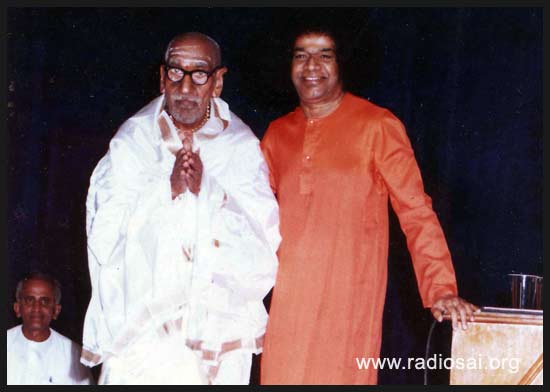 |
|
| Bhagawan with Brahmasri Kamavadhani Garu |
The Memorable First Vinayaka Chathurthi
The year 1976 was the first time I had the great good fortune to be with the Lord on Vinayaka Chathurthi Day. I had just joined Bhagawan's College in Brindavan (Bengaluru). That particular day Swami came to the hostel and He brought with Him Brahmasri Kamavadhani Garu (an esteemed Vedic scholar) to do the pooja. We had a Ganesha idol made and Swami personally came and sat for the worship. While this was going on the first thing Swami asked was, “Where is Ganesha?” Kamavadhani Garu could not answer. The next moment Swami waved His hand and out came a beautiful silver Ganesha. He placed this creation in the shrine.
Then Swami asked again, “How can the son be there without the mother? The mother also should be there.” Swami's hand again moved in a circle and this time He materialised a lovely statue of Mother Parvathi. Baba handed this over too and said that both should be worshipped. I clearly remember that amazing scene because it was the first time we were seeing Swami creating a Ganesha and Parvathi idol, hand in hand.
Dr. Lakshminarasimhan was our assistant warden then and he felt that daily worship should be done for those two creations of Bhagawan. I had the great good fortune of doing this for at least four years. In fact, that was the same day the Sri Sathya Sai General Hospital in Whitefield was inaugurated by Swami; that happened in the evening.
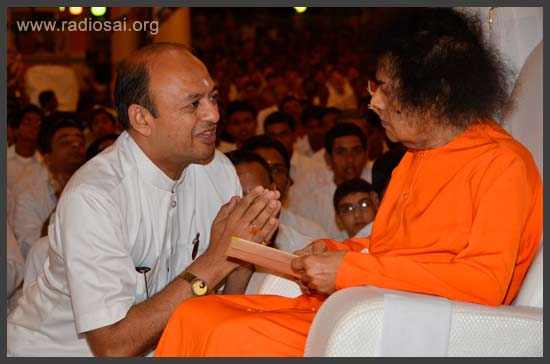 |
|
| Mr. Veda Narayan with Bhagawan Baba |
A Mouse Brings the Joy of the Lord's Presence
When I was in the hostel in Brindavan, some boys felt that instead of buying Ganesha idols from the market we could make our own Ganesha. So they brought clay from somewhere. At that time the adjacent hostel which was a relatively new construction (which is called the S. N. Singh Block) was not yet occupied. So in the basement boys had put a wooden structure on which they were about to start their work in clay. Suddenly a small rat appeared from nowhere and went straight under the plank where the Ganesha statue was to be built. The boys did not disturb it. The making of the Ganesha took nearly four days. Interestingly that little rat did not go anywhere and stayed on till the idol was completed.
Those days during darshan we never used to sit down to see Bhagawan. Being very few in number we actually used to walk around Swami whenever He went for darshan. That day Swami came out and spotted the boy who was making the Ganesha idol and spontaneously asked him, “How is the Ganesha?” The boy replied, “Swami, by Your grace everything is coming up well”. Then Swami asked, “How is that little rat?” Only then it occurred to us that it was Swami who was actually present there all the time and guiding the making of that idol.
Even the Vedas Extol Lord Ganesha
The aspect of Ganesha exists from time immemorial because Ganesha is one of the Vedic Gods. Rig Veda is considered as the one of the oldest Vedas, and in this there is a description and a prayer to Lord Ganesha. The Ganesha Suktam that we chant in the Mandir in Prasanthi Nilayam is from the Rig Veda.
Swami once said that the beauty of Lord Ganesha is that irrespective of caste everybody worships Him. He is the Vighna Vinashaka – the remover of all obstacles. He is also the pradata (giver) of siddhi (attainment) and buddhi (intelligence) without which we cannot lead our lives.
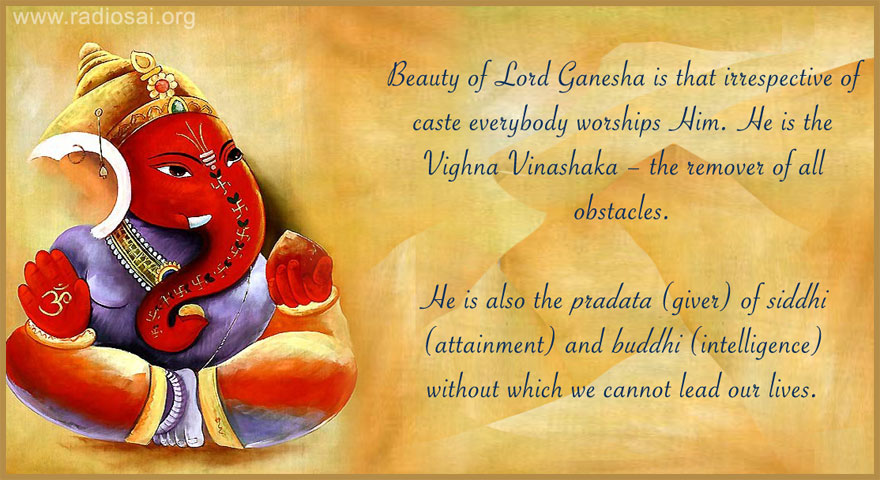 |
The Ganapathi Atharvashirsham actually describes how Lord Ganesha should be worshipped and in this a powerful Beeja mantra (a potent mantra) is also described. If you chant this, it is said, you will definitely get the vision of Lord Ganesha.
A Special Vision of the Endearing Lord
I somehow got attached to Lord Ganesha and I had been intensely praying. From the beginning my mind has been more of a rationalist. I want to experiment everything without which I do not accept or tell anybody anything. So I took this up as a challenge and started chanting that Beeja mantra. The result was that one day Swami did give me the vision of Himself as Lord Ganesha! I saw Ganesha in the form of a little baby with a small trunk and small ears, shaking his head this way and that way; it was simply a lovely and enthralling experience. All this shows that whenever we do something sincerely, the result is assured; there is absolutely no doubt.
Many are familiar with the story of Swami giving the vision of the golden Ganapathi to Swami Amritananda from the Ramana Ashram. Swami Amritananda was in the Ramana Ashram before He came to Swami. He was not a devotee of Swami but had heard about Him.
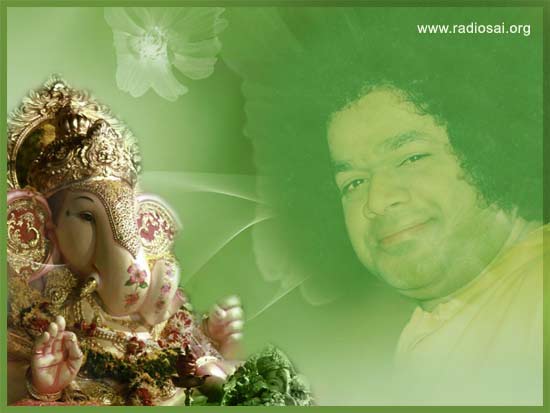 |
When he came to Prasanthi Nilayam, the first thing Swami did was to call him just as Ramana used to – using his pet name ‘Amritam’. That was the first thing which struck him. The second thing was that Swami took him to the inner interview room. Those days there was no special room at all. If Swami wanted to speak to someone, He used to call them to the staircase room. Those who have gone inside that room know that there is hardly any space; there is room only for one person and Swami to stand; that's all. Beside is the winding staircase that goes upstairs.
There Swami asked him, “Do you remember a yajna (sacrifice) which you performed as a boy of seven?” He said, “Yes Swami, I did a Ganapathi Homam”. What was that Ganapathi Homam? For 21 days he had to chant a mantra and then offer 1008 coconuts to the sacred fire; that was the yajna.
In those days there were plenty of coconut trees. The Nambudiris (a particular community of Brahmins) were very wealthy and everything was taken care of for them. So as a boy he performed such a yajna for 21 days. I found that the Beeja mantra to be chanted is exactly the same thing as mentioned in the Ganapathi Atharvashirsham. Amritananda as a little boy had chanted that mantra, offered the coconuts and performed this ritual diligently.
Swami asked him, “What is the phalasruthi (the promised reward according to the scriptures)?” He said, “Swami, at the end of the 21 days Ganapathi will appear in a golden form in the fire and will accept the final offering.” Then Swami asked him, “Did it happen?” He said, “No Swami, maybe because I was only a small boy.”
Swami then said, “No if in the scriptures it has been said that it has to happen, it will happen. There is no question of one being small or big.” Swami added, “That is the main reason why you are here today. Now I will grant you that vision.”
Then Bhagawan appeared before him with the brilliance of crores of suns – as said in the scriptures ‘Koti Surya Sama Prabha’. Immediately after that Amritananda swooned. I remember Prof. Kasturi telling us later that he had to be shifted to a room where he took rest for three days before he became normal. That was his revealing experience.
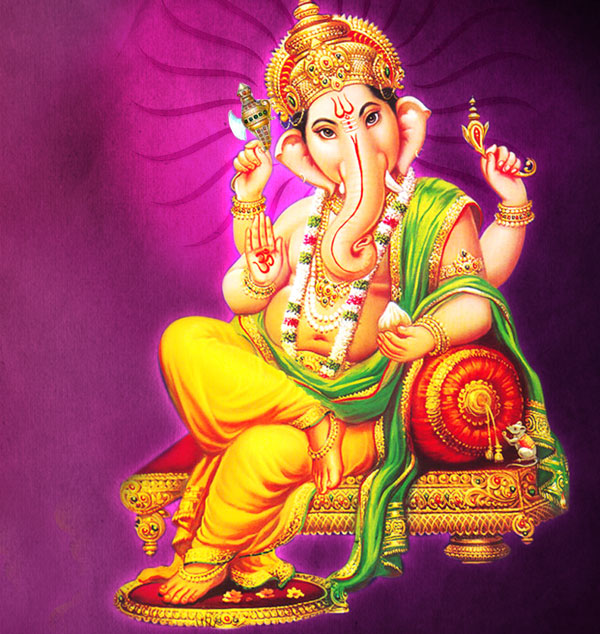 |
The Significance of Worshipping the Elephant-Faced Lord
Now, what is the significance of worshipping this little beautiful Lord Ganesha? Unlike any other God, he has an elephant head. Elephants are the most intelligent animals. They are the leaders, as it is said ‘Vigataha Nayakaha’. Elephants go in the front; nothing is an obstacle for them. They remove all the trees and in the forest they make their own way. In fact, all the other animals prefer to go behind an elephant to find their way. Even in a dense forest, elephants will find their own way. That is another significance of Lord Ganesha having the elephant head. He removes all the obstacles from our life – be they material or spiritual.
Lord Ganesha has four hands. In one hand He has a Pasha (rope) and in another He has an Ankusha (axe). In the third He has a sweet and with the fourth He is showing Abhayam (blessings).
What is the significance of these? If you pray to Lord Ganesha, what does He do? He will first start alluring you by showing you the sweet. He says, “Come, I will give you the sweet”. Everybody likes sweets and so we go near Ganesha.
When you go near Him, what does He do? With the Pasha or the rope He ties you to Himself and does not allow you to go. Then with His axe He cuts asunder all your worldly ties. Finally what does He give you? He gives you Abhayam or protection. This is the significance of what He holds in His four hands – Pasha, Ankusha, the sweet as well as the Abhayahastha mudra.
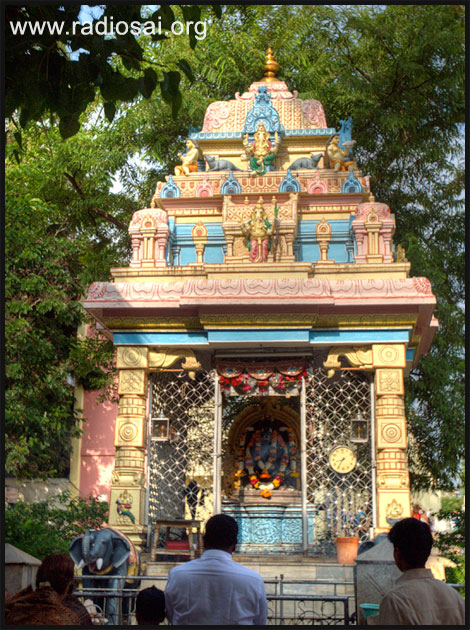 |
|
| The majestic Ganesh Mandir is the first scene that greets us when we walk in to the Prasanthi Nilayam ashram |
He has got as a vahana (vehicle) a small mouse or mooshika. It is not even a full-grown rat, just a baby. We might wonder how a huge-bellied Ganesha can ride on such a small mouse. The inner significance is that the mouse is something which always loves darkness. Mice are present wherever there is darkness; they don't like light at all. The mouse represents our inner darkness or our ignorance. Lord Ganesha sits on the mouse and when He is there everything is illumined. So He is also the deity who removes our ignorance and gives us buddhi and siddhi. That is why we worship Lord Ganesha before anybody else.
In the Kali Yuga, a few deities are said to be very powerful. One is Lord Ganesha and another is Devi. These deities are like our Lord – sulabha prasanna, as they get pleased easily and manifest in front of devotees. To get a vision of Lord Krishna or even of Lord Shiva is very difficult but getting a vision of Lord Vinayaka is very easy. He is like a child who can be pleased easily.
Ganesha - The Favourite Child of Our Bhagawan
Over the years Swami has given a lot of importance to Lord Ganesha. We can see at the entrance of Prasanthi Nilayam Lord Ganesha sitting and receiving all the devotees who come inside. When God has taken Avatar and we go for His darshan, just imagine who is welcoming us. It is really His own son!
It is natural that when we go to anybody's house either the main person or somebody who is mainly in charge of the house comes out and welcomes us. It is so significant that the little Lord Ganesha sits there and welcomes each and every one of us because He loves to directly take us to His Lord.
He assures us saying, “You have come to the right place. Here are my parents (Baba being the Shiva-Shakthi Avatar) waiting for you. Please come and see. You are entering the Abode of Supreme Peace. The Lord is going to grant you supreme peace not only for this life but even for lives to come.” That is why Swami had installed Him there, right at the gate.
Not only that, for children's sake He has installed a Ganesha in the Institute. Later during the 60th birthday when the stadium construction was on, various deities were brought. There were also a little Ganesha and Parvathi. Swami was gracious enough to send that Ganesha to the Higher Secondary School. It was a huge seven-foot statue. Even today He sits in front of our school and before going inside all the children salute Him. During examination time He is in full demand!
Apart from this when the Sai Kulwant Hall was constructed, a Vinayaka idol was brought. It was black in colour and had an old and archaic look. Swami felt that it should be more of a golden colour. So He said, “Why don't you boys try to remove the black colour and polish it?”
 |
We tried our level best but it was not happening. Swami Himself personally observed us doing this. We started polishing the back of the statue but then Swami said, “Just leave it. Don't do anything.” That Ganesha was installed as the main deity behind Bhagawan's chair as He sat in the Sai Kulwant Hall.
After the Mahasamadhi in April 2011, when the authorities felt that Swami's Samadhi had to come up at that place, a question arose as to where to shift this Ganesha. Temporarily He was kept inside. Later I found that they wanted to install the same Ganesha in front of the Gopuram gate, which was now open for devotees. When people enter through this gate, there is a Ganesha here too. This is all divine sankalpa (will). Not only that, on the day of this installation I was there and I could not believe it was the same old Ganesha because the authorities had sent the idol for polishing. When it came, it was a golden Ganesha which Swami wanted from day one!
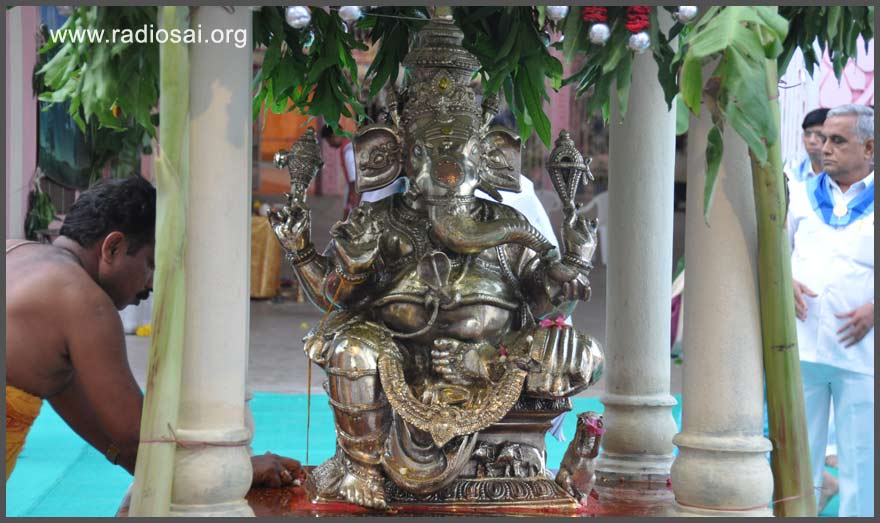 |
| The Ganesha idol that was installed behind the dais on which Bhagwan sat for decades, is now installed in front of the Gopuram gate for all devotees to worship |
It might be something very insignificant but He had already made the sankalpa that it was going to be a golden Ganesha. That is what happened; it is just that it took its own time. That day when I saw the installation of Lord Ganesha in between the statues of Lord Rama, Lakshmana, Sita and the Gopuram Gate I could not believe my eyes. Everything has its own beautiful time.
We have to pray to the Lord to grant us that siddhi and buddhi so that we learn to surrender to His will and lead a life in tune with the divine all the time.
What are your impressions about this article? Please share your feedback by writing to h2h@radiosai.org. Do not forget to mention your name and country.






